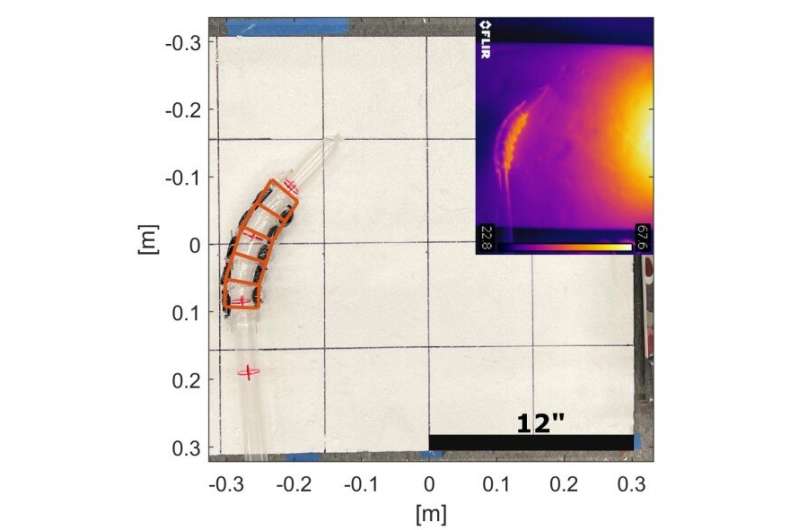Model verification on a section of robot. The predicted shape is drawn in orange. Inset shows the infrared image of a similar test setup. Credit: arXiv (2023). DOI: 10.48550/arxiv.2301.07362
A group of robot engineers at the University of California Santa Barbara has designed and built a robot that mimics the way roots and vines move toward moisture sources. They describe their approach and robot prototype in a paper uploaded to the arXiv preprint server.
As robot technology continues to mature, scientists and engineers around the world seek new sources of inspiration. In this new effort, the researchers looked at the way plants send roots to moisture sources and vines spread across the environment. The result is a robot that is capable of turning as it expands toward a heat source.
The robot is approximately 2 meters long and was built using thin, flexible bags filled with Novec 7000—a type of refrigerant. The bags, which were shaped like a sleeve, were then divided into 4.5-cm segments. As the robot bends to move toward a heat source, the segments adjust to accommodate the move. The side closest to the heat source grows shorter, while the side opposite stretches and becomes longer. The robot is incited to move by temperature change when its refrigerant begins evaporating at 34°C. In action, it resembles a segmented worm.
The engineers tested their robot by placing it in different environments and watching how well it performed. They found it capable, for example, of navigating around small objects. They also found that it could bend toward a heat source even if bent backward away from it. They also noted that the robot has eversion capabilities, in which robots extend or unfurl themselves. In the case of the new prototype, the robot was able to pull itself inward, resembling pulling a shirt sleeve inside-out.
The researchers suggest their robot might prove useful for snuffing out a heat source. By arming it with hoses able to pump water or other material, the robot could move to the source of a fire, for example, where dousing material could be deployed. The group concludes by noting that their robot was inexpensive to build, which means it could be an inexpensive tool for use by firefighters. They plan to continue improving their robot, looking to make it move faster and to initiate at different temperatures.
More information: Shivani Deglurkar et al, Thermotropic Vine-inspired Robots, arXiv (2023). DOI: 10.48550/arxiv.2301.07362
Journal information: arXiv
© 2023 Science X Network
























